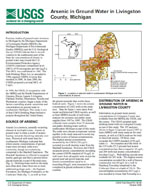Arsenic in ground water in Livingston County, Michigan
Links
- Document: Report (pdf)
- Download citation as: RIS | Dublin Core
Abstract
Previous studies of ground-water resources in Michigan by the Michigan Department of Community Health (MDCH), the Michigan Department of Environmental Quality (MDEQ), and the U.S. Geological Survey (USGS) indicate that in several counties in the southeastern part of the State the concentrations of arsenic in ground water may exceed the U.S. Environmental Protection Agency (USEPA) maximum contaminant level (MCL) of 50 micrograms per liter [µg/L]. This MCL was established in 1986. The Safe Drinking Water Act, as amended in 1996, requires USEPA to revise this standard in 2000. In June 2000, the USEPA proposed a revised MCL of 5 µg/L.
In 1996, the USGS, in cooperation with the MDEQ and the Health Departments of Genesee, Huron, Lapeer, Livingston, Oakland, Sanilac, Shiawassee, Tuscola and Washtenaw counties, began a study of the factors controlling arsenic occurrence and concentrations in ground water in southeastern Michigan. This study is one of four USGS Drinking Water Initiative projects throughout the United States.
Study Area
| Publication type | Report |
|---|---|
| Publication Subtype | USGS Numbered Series |
| Title | Arsenic in ground water in Livingston County, Michigan |
| Series title | Fact Sheet |
| Series number | 130-00 |
| DOI | 10.3133/fs13000 |
| Year Published | 2000 |
| Language | English |
| Publisher | U.S. Geological Survey |
| Publisher location | Lansing, MI |
| Contributing office(s) | Michigan Water Science Center |
| Description | 2 p. |
| Country | United States |
| State | Michigan |
| County | Livingston County |


